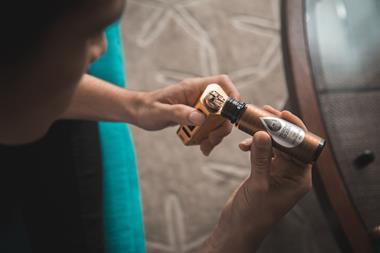Small, healthy redhead with a highly polished appearance and vast earning potential seeks chilled out partner for a long-lasting and fruitful relationship well, for five or six days at least. After that she'll probably be past her best and good for nothing but a fruit pot or pig feed.
No, don't worry, you haven't stumbled upon a dodgy dating feature, we are, of course, talking about the mouth-watering miss red apple and her perfect partner, the convenience store chiller.
Demand for fresh fruit and vegetables has been on the up since 2006, according to the IGD, and at the last count almost half of all shoppers (43% to be exact) said they now eat five portions a day. But fruit and veg's rising star is not only great news for your customers' waistlines if done properly, it will also result in healthy profits for you, as this is one area where c-stores and even CTNs are better placed to sell the colourful stuff than their competitors.
Just ask Bimal Patel, who owns the enviable Londis in London's cosmopolitan Crouch End with his brother Alpesh. The brothers saw the category's potential some years ago and, thanks to various investments in space, equipment and training, have managed to make a rip-roaring success of it in their store. "Fresh fruit and vegetables are far more valued commodities than they were five years ago," says Bimal. "Virtually every basket that goes through our till now contains at least one or two bits of fruit or veg, and it now accounts for more than 15% of our turnover in the week, rising to more than 20% on weekends." In fact, sales of fruit and vegetables in Londis stores have increased by 66% in the past year as the number of stores hoping for similar success has shot up.
However, despite the vast opportunity that fresh poses, ill-founded fears over ranging, costs and wastage mean that many non-affiliated c-store retailers still give it a wide berth.
Confusion over what products to stock and in what quantities is one of the biggest barriers, says Rice Retail Marketing founder Stephanie Rice, who has been heavily involved in the Change4Life healthy eating programme.
She makes the point that retailers don't have to jump in feet first, but can start off on a small scale, offering a select range of common fruits and vegetables. "People don't want their convenience stores to be greengrocers," says Rice. "They don't need to be stocking a vast range of products, just a small but high-quality range of essential and impulse items."
Peter Clarke, former greengrocer and business development manager at the Western International Market, near Heathrow, agrees. According to Clarke, there are 10 essential products that convenience store retailers should stock (see panel above). "This list ensures that you have the two most popular fruits and three basic vegetables that a person would need to cook a meal, as well as a couple of salad items," Peter says. "It's the best way to start out, and if at a later stage you want to try to expand your range, then trial different products when they're in season in the UK and therefore cheap to buy.
For example, you can buy courgettes all year round, but during July and August the UK crop is available much cheaper, so that's the time to try them out. If they sell, great, but if they don't you haven't wasted much money."
In addition to losing money, fear over waste is the primary deterrent for most retailers. But there are some incredibly simple ways that this can be avoided, by storing products correctly and adopting a few simple techniques to lengthen shelf life.
Eight of the 10 essential items should be stored in a chiller, or at least in a cool environment the exceptions being onions and bananas. "One of the most common mistakes is for retailers to put bananas in the chiller, which will prevent them from ripening and turn them grey," Rice says.
Another hot tip to extend the shelf life of light-sensitive bananas and potatoes is to put a black plastic bag over them at night.
And when the shelf life of fruit draws near, making up a few sample pots to hand out is a great way to use up nice ripe products, and hopefully prompt repeat purchases.
But if you're not keen on handing them out for free, here's another idea: "A nice juicy pineapple can be cut up and divided into three pots, with best before labels on them, which you could sell for £1.50 each," suggests Rice.
Being able to adapt is also key in this category, says Bimal, who has managed to reduce his fruit and vegetable wastage to less than 4%. "You have to be flexible and respond to shopper needs. For example, we allow people to break bananas off the bunch if they want single ones. We also use a local supplier to bolster our Londis range with more unusual products that customers have requested."
Staff training is another must in the battle against the bin. "This is a category where looks and quality really matter," adds Bimal. "Just one bad apple will spoil people's impression of the lot, costing you a sale and potentially repeat custom." Staff in his store are trained to check the range each time they pass by and a full inspection is conducted every three hours to ensure that the display is kept looking pristine.
Clearly, buying quality products in the first place is vital. The past couple of years have seen the UK's big wholesalers make great strides in this area, improving both the quality of product and the choice for their retail customers.
"When it comes to fruit and veg we're now better than we've ever been, although there's still a long way to go," says Booker category manager for fruit and vegetables and ex-greengrocer Martin Hartshorne.
"Retailers can now get everything from a bag of onions to butternut squash at competitive prices and in formats which suit them."
Booker now offers seven lines of prepacked pricemarked products specifically for convenience stores, which Hartshorne says will offer retailers at least 30% profit on return and boost their confidence in the category.
And that confidence is already starting to manifest itself in the form of a 25% increase in fruit and vegetable sales on last year to Booker's retail members.
Bestway operations director Martin Race says he is encouraged by the gradual increases in retailer demand for fresh fruit and vegetables over the last year.
Both Bestway and Batleys are now heavily promoting the category on their websites, and have boosted the number of fruit and veg deals. If retailers are in any doubt, they can rely on branch managers to offer stocking advice and insight.
However, one place which can offer retailers virtually unrivalled category advice is the fresh produce wholesale market, and as consumer desire for more exotic produce grows, Clarke says that more and more retailers are turning to the markets to expand their ranges. "Yes, coming to the markets in person is an investment in time as you need to be there very early in the morning, but the rewards totally outweigh this downside," he says. "The quality and range is fantastic and markets also give you a much better grip on seasonality." If you can't get to a market, a local secondary supplier is the next best thing, but expect to pay more.
Of course, there's no point having all these perfect products if your customers aren't aware of them. If you can't stock products close to the entrance, then dual siting a small number of single portion products such as apples, bananas and oranges at the till point to drive awareness of the range is a great idea. "Making single fruit a hero is key," Rice adds. "If customers see it right in front of them looking juicy and good they'll buy it, virtually regardless of price.
"Many retailers have found that they can double the amount of bananas they sell by removing the packaging and selling them as singles. This appeals to school children who have limited spend, mothers who are looking for a healthy snack for their children, and those lunchtime customers who want to complement their sandwich."
One retailer who can certainly attest to this is Des Barr, of Sinclair Barr Newsagents in Paisley, Renfrewshire. "I only have a small CTN so I've concentrated on single portion fruits and I've been astounded by the response," he says. "I'm now selling more than 40 loose apples a day which, for a small store like mine, is a huge amount. There's good profit on them, too."
So what are you waiting for? It's time to get out there and pick up some dates. It could be the start of a beautiful friendship.
No, don't worry, you haven't stumbled upon a dodgy dating feature, we are, of course, talking about the mouth-watering miss red apple and her perfect partner, the convenience store chiller.
Demand for fresh fruit and vegetables has been on the up since 2006, according to the IGD, and at the last count almost half of all shoppers (43% to be exact) said they now eat five portions a day. But fruit and veg's rising star is not only great news for your customers' waistlines if done properly, it will also result in healthy profits for you, as this is one area where c-stores and even CTNs are better placed to sell the colourful stuff than their competitors.
Just ask Bimal Patel, who owns the enviable Londis in London's cosmopolitan Crouch End with his brother Alpesh. The brothers saw the category's potential some years ago and, thanks to various investments in space, equipment and training, have managed to make a rip-roaring success of it in their store. "Fresh fruit and vegetables are far more valued commodities than they were five years ago," says Bimal. "Virtually every basket that goes through our till now contains at least one or two bits of fruit or veg, and it now accounts for more than 15% of our turnover in the week, rising to more than 20% on weekends." In fact, sales of fruit and vegetables in Londis stores have increased by 66% in the past year as the number of stores hoping for similar success has shot up.
However, despite the vast opportunity that fresh poses, ill-founded fears over ranging, costs and wastage mean that many non-affiliated c-store retailers still give it a wide berth.
Confusion over what products to stock and in what quantities is one of the biggest barriers, says Rice Retail Marketing founder Stephanie Rice, who has been heavily involved in the Change4Life healthy eating programme.
She makes the point that retailers don't have to jump in feet first, but can start off on a small scale, offering a select range of common fruits and vegetables. "People don't want their convenience stores to be greengrocers," says Rice. "They don't need to be stocking a vast range of products, just a small but high-quality range of essential and impulse items."
Peter Clarke, former greengrocer and business development manager at the Western International Market, near Heathrow, agrees. According to Clarke, there are 10 essential products that convenience store retailers should stock (see panel above). "This list ensures that you have the two most popular fruits and three basic vegetables that a person would need to cook a meal, as well as a couple of salad items," Peter says. "It's the best way to start out, and if at a later stage you want to try to expand your range, then trial different products when they're in season in the UK and therefore cheap to buy.
For example, you can buy courgettes all year round, but during July and August the UK crop is available much cheaper, so that's the time to try them out. If they sell, great, but if they don't you haven't wasted much money."
In addition to losing money, fear over waste is the primary deterrent for most retailers. But there are some incredibly simple ways that this can be avoided, by storing products correctly and adopting a few simple techniques to lengthen shelf life.
Eight of the 10 essential items should be stored in a chiller, or at least in a cool environment the exceptions being onions and bananas. "One of the most common mistakes is for retailers to put bananas in the chiller, which will prevent them from ripening and turn them grey," Rice says.
Another hot tip to extend the shelf life of light-sensitive bananas and potatoes is to put a black plastic bag over them at night.
And when the shelf life of fruit draws near, making up a few sample pots to hand out is a great way to use up nice ripe products, and hopefully prompt repeat purchases.
But if you're not keen on handing them out for free, here's another idea: "A nice juicy pineapple can be cut up and divided into three pots, with best before labels on them, which you could sell for £1.50 each," suggests Rice.
Being able to adapt is also key in this category, says Bimal, who has managed to reduce his fruit and vegetable wastage to less than 4%. "You have to be flexible and respond to shopper needs. For example, we allow people to break bananas off the bunch if they want single ones. We also use a local supplier to bolster our Londis range with more unusual products that customers have requested."
Staff training is another must in the battle against the bin. "This is a category where looks and quality really matter," adds Bimal. "Just one bad apple will spoil people's impression of the lot, costing you a sale and potentially repeat custom." Staff in his store are trained to check the range each time they pass by and a full inspection is conducted every three hours to ensure that the display is kept looking pristine.
Clearly, buying quality products in the first place is vital. The past couple of years have seen the UK's big wholesalers make great strides in this area, improving both the quality of product and the choice for their retail customers.
"When it comes to fruit and veg we're now better than we've ever been, although there's still a long way to go," says Booker category manager for fruit and vegetables and ex-greengrocer Martin Hartshorne.
"Retailers can now get everything from a bag of onions to butternut squash at competitive prices and in formats which suit them."
Booker now offers seven lines of prepacked pricemarked products specifically for convenience stores, which Hartshorne says will offer retailers at least 30% profit on return and boost their confidence in the category.
And that confidence is already starting to manifest itself in the form of a 25% increase in fruit and vegetable sales on last year to Booker's retail members.
Bestway operations director Martin Race says he is encouraged by the gradual increases in retailer demand for fresh fruit and vegetables over the last year.
Both Bestway and Batleys are now heavily promoting the category on their websites, and have boosted the number of fruit and veg deals. If retailers are in any doubt, they can rely on branch managers to offer stocking advice and insight.
However, one place which can offer retailers virtually unrivalled category advice is the fresh produce wholesale market, and as consumer desire for more exotic produce grows, Clarke says that more and more retailers are turning to the markets to expand their ranges. "Yes, coming to the markets in person is an investment in time as you need to be there very early in the morning, but the rewards totally outweigh this downside," he says. "The quality and range is fantastic and markets also give you a much better grip on seasonality." If you can't get to a market, a local secondary supplier is the next best thing, but expect to pay more.
Of course, there's no point having all these perfect products if your customers aren't aware of them. If you can't stock products close to the entrance, then dual siting a small number of single portion products such as apples, bananas and oranges at the till point to drive awareness of the range is a great idea. "Making single fruit a hero is key," Rice adds. "If customers see it right in front of them looking juicy and good they'll buy it, virtually regardless of price.
"Many retailers have found that they can double the amount of bananas they sell by removing the packaging and selling them as singles. This appeals to school children who have limited spend, mothers who are looking for a healthy snack for their children, and those lunchtime customers who want to complement their sandwich."
One retailer who can certainly attest to this is Des Barr, of Sinclair Barr Newsagents in Paisley, Renfrewshire. "I only have a small CTN so I've concentrated on single portion fruits and I've been astounded by the response," he says. "I'm now selling more than 40 loose apples a day which, for a small store like mine, is a huge amount. There's good profit on them, too."
So what are you waiting for? It's time to get out there and pick up some dates. It could be the start of a beautiful friendship.
Pricing guide
With perishables, such as strawberries and mushrooms, you should double the price you have paid for them With longer shelf life products, such as onions or apples, add 35% to the wholesale price
With perishables, such as strawberries and mushrooms, you should double the price you have paid for them With longer shelf life products, such as onions or apples, add 35% to the wholesale price
Top of the crops
1. Potatoes in prepacked 2kg bags) 2. Carrots 3. Onions 4. At least one of the brassica family - cauliflower or broccoli) 5. Tomatoes 6. Cucumber 7. Lettuce 8. Citrus - either oranges or satsumas 9. Bananas 10. Apples Source: Peter Clarke, former green- grocer and business development manager at the Western International Market
1. Potatoes in prepacked 2kg bags) 2. Carrots 3. Onions 4. At least one of the brassica family - cauliflower or broccoli) 5. Tomatoes 6. Cucumber 7. Lettuce 8. Citrus - either oranges or satsumas 9. Bananas 10. Apples Source: Peter Clarke, former green- grocer and business development manager at the Western International Market
Secrets of success
Make one member of staff the produce champion. The extra responsibility will make them feel valued and you should be rewarded with a much better looking offer Site at least one product near the tills as well as in the main section. Single portion apples are perfect for this Cross-promote associated categories Try to stock British wherever possible and when you do, really shout about it - even a simple Union Jack flag on your local lettuce will make an impact Try to have a best buy every day. It gives shoppers a perception of value without impacting too heavily on your margins. Source: Peter Clarke, former greengrocer and business development manager at the Western International Market
Make one member of staff the produce champion. The extra responsibility will make them feel valued and you should be rewarded with a much better looking offer Site at least one product near the tills as well as in the main section. Single portion apples are perfect for this Cross-promote associated categories Try to stock British wherever possible and when you do, really shout about it - even a simple Union Jack flag on your local lettuce will make an impact Try to have a best buy every day. It gives shoppers a perception of value without impacting too heavily on your margins. Source: Peter Clarke, former greengrocer and business development manager at the Western International Market























No comments yet